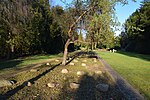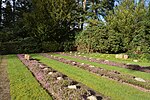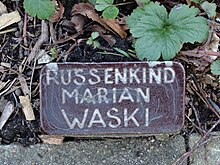Russian and Soviet war cemeteries in the city of Neumünster
In Neumünster in Schleswig-Holstein , Russian and Soviet war cemeteries from both world wars in Schleswig-Holstein have been identified. These are located in the north and south cemetery in Neumünster and in the Einfeld district . These are war graves with 106 Russian prisoners of war from the First World War , graves with more than 200 Soviet prisoners of war and slave labor from the Second World War, and around 60 people in single fields. The grave fields were also occupied by Polish prisoners of war and Eastern workers , the latter also including women and their children.
The burial places were mostly set up on the outskirts of the cemeteries and are difficult to find today. A detailed list of the war victims is missing and the numbers of those buried in various sources are difficult to compare.
history
Neumünster had about 54,000 inhabitants in 1938 and at that time owned an important leather industry that was important to the war effort . The city belonged to the military district X of the Greater German Reich . Prisoners of war were used via the Stalag XA (main camp, actually prisoner of war team main camp) in Schleswig to the north , in industrial companies, in agriculture, but also in the transport sector. In July 1944, the armaments factory for agricultural and soul construction in the Holstenhalle employed almost 1,000 Russians and Poles who were housed in two barracks . The list of workers at the Neumünster station of the Deutsche Reichsbahn records the entry of 27 “Polish workers” from June to November 1942.
In addition, there were forced laborers who were abducted from the occupied territories in the east or who were also recruited there. In the spring of 1942, a transit camp (Dulag) for Eastern workers was set up in Neumünster-Wittorf . It comprised 30 barracks and provided Schleswig-Holstein with workers. The Norddeutsche Lederwerke (until July 1940 Adler & Oppenheimer ) maintained a camp in Wittorf with 111 Eastern workers (1943). There were also 32 camps in the city in 1944 and 3,904 people were doing forced labor. Around 100 of them were killed in Allied bombing raids because they were not allowed to visit air raid shelters . Strict edicts and gender segregation applied to Eastern workers. But there were also births. For example, infants who often died early due to a lack of adequate care were buried as “Russian” and “Polish” children.
In June 1944, the city of Neumünster laid out the so-called "Russenfriedhof" because "the only cemetery in Neumünster is being overused". The people buried there were a few months to 80 years old. The model was the “special cemetery for Ukrainians, Soviet Russians and Poles” in neighboring Boostedt . Neumünster was handed over to British troops on May 3, 1945 without a fight . That ended the forced labor. A total of 1077 people died as a result of the war in Neumünster.
Today's grave fields were redesigned in 1954 and 1955 after the first installations in 1914–1918 and 1939–1949. In the process, some relocations were made at the facility and in 1948. The garden architect Carl von Schierstedt undertook the planning in cooperation with the Volksbund Deutscher Kriegsgräberfürsorge . The costs were borne by the state of Schleswig-Holstein. The dead are buried in individual and collective graves.
The graves law in Germany guarantees the inviolability of these graves. That is why they can sometimes be found as individual graves in otherwise cleared burial fields. The “Friedhofsverwaltung des Ev.-Luth. Kirchengemeindeverbandes ”in Neumünster.
description
The grave site for 106 Russian prisoners of war of the First World War consists of a long field with rows on each of which there are four or five grave sites. The graves are marked with "pillow stones", the first and last names are carved into the natural stones. The grave field in the “NO I” section is 30 meters long and 10 meters wide.
The sources on the buried are difficult to grasp. According to the Russian Museum Berlin-Karlshorst , 242 victims of the Second World War were buried in the Nordfriedhof, while the cemetery administration's register lists 167 buried persons known by name and two unknown persons and the Neumünster search for clues names around 330 slave laborers.
The grave site for 242 victims of the Second World War, mostly of Polish and Soviet origin, is marked by a memorial stone in Russian : 200 Soviet citizens are buried here who died in fascist bondage . The German memorial stone in the north cemetery bears the inscription: 119 Russians and Poles rest here 1943–1945 .
A cross was erected for the Poles, in front of which there is a stone with the inscription in Polish : Faithful to the Fatherland in the war years 1939–1945, compatriots and other peoples rest here. Poland. Later, relatives erected some memorial stones with inscriptions in Polish or Lithuanian near the graves . The graves are laid out along several paths. Their names can be found on small clay stones. The grave field in section "O III" is 15 meters long and 15 meters wide.
Graves with 55 Soviet war graves in the southern cemetery are located in the extensive grave fields "Eb" (sacrificial field) and "Ha – Hd" (bomb victims and soldiers' graves). The graves are marked by "pillow stones" with names inscribed.
An unknown number of Soviet prisoners of war and forced laborers are buried in Einfeld. According to the German-Russian Museum Berlin-Karlshorst, most of the 125 dead originally buried here were reburied in Boostedt. The memorial stone in Einfeld bears the inscription The Unknown Victims 1933–1945 . Of those buried here, 65 prisoners of war and forced laborers from the Soviet Union, Estonia and Latvia were reburied in the Boostedt municipal cemetery in 1948 and buried in three collective graves. Einfeld was not yet part of Neumünster in 1948 and was not incorporated into the municipality until 1970.
Location of the graves
| image | place | location | address | Grave complex |
|---|---|---|---|---|

|
Neumunster | (Location) | Neumünster, Nordfriedhof (WWI war cemetery) | Grave site for 106 Russian prisoners of war of the First World War |
  |
Neumunster |
(Location)
(Location) |
Plöner Straße, Neumünster, Süd- and Nordfriedhof (grave complex) Grave field with many children's graves of forced and eastern workers in the north cemetery |
Grave site for 242 victims of the Second World War, mostly of Polish and Soviet origin Note 2 |

|
Neumünster- Einfeld | (Location) | Dorfstrasse, Neumünster-Einfeld, cemetery (grave complex) | Memorial stone in Einfeld, a large part of the Soviet prisoners of war and forced laborers originally buried here were reburied in Boostedt . |
literature
- Gerhard Hoch, Rolf Schwarz (ed.): Deported to slave labor - prisoners of war and forced laborers in Schleswig-Holstein. Alveslohe 1985.
Web links
- Soviet war cemeteries in Germany
- War graves in Neumünster
- Plan of the north cemetery
- Plan of the south cemetery
- Plan of the Einfeld cemetery
Footnotes
- ↑ Officers had no work assignments.
- ↑ spurensuche-neumuenster.de: Land und See Leichtbau GmbH. (accessed on May 8, 2020)
- ↑ collections.arolsen-archives.org : Polish Workers No. 505-531 , in: Lists of names of people who were employed by the Deutsche Reichsbahn, Neumünster station, entry dates: 02.11.39-10.10.49. (accessed on May 6, 2020)
- ^ Neumünster district. In: Nils Köhler, Sebastian Lehmann: Camps, accommodation for foreigners and prisoner-of-war commands in Schleswig-Holstein 1939-1945. Pp. 24-25. (PDF at vimu.info, accessed on May 8, 2020)
- ↑ a b spurensuche-neumuenster.de: Nordfriedhof. (accessed on May 8, 2020)
- ↑ spurensuche-neumuenster.de: Boostedter Friedhof. (accessed on May 8, 2020)
- ↑ The year 1945. Neumünster. (accessed on: May 8, 2018)
- ↑ spurensuche-neumuenster.de: Südfriedhof. (accessed on May 8, 2020)
- ^ Friedhof-neumuenster.de: War graves. (accessed on May 8, 2020)
- ↑ a b c d friedhof-neumuenster.de: tab of the Neumünster war cemetery. (Nordfriedhof , PDF, accessed May 8, 2020).
- ↑ sowjetische-memoriale.de : Neumünster. World War I war cemetery / community cemetery. (accessed on May 6, 2020).
- ^ German-Russian Museum Berlin-Karlshorst | sovjetische-memoriale.de
- ^ Sovietische-memoriale.de : Neumünster. Grave complex / south and north cemetery. (accessed on May 6, 2020).
- ^ Poland in terms of persons, not of the country; see Wikipedia information: Request for translation (permalink)
- ^ Friedhof-neumuenster.de: tab of the Neumünster war cemetery. (Südfriedhof , PDF, accessed May 8, 2020).
- ^ Sovietische-memoriale.de : Neumünster-Einfeld. Grave complex / cemetery. (accessed on May 6, 2020).
- ^ Sovietische-memoriale.de : Boostedt. Grave complex / community cemetery. (accessed on May 6, 2020).






